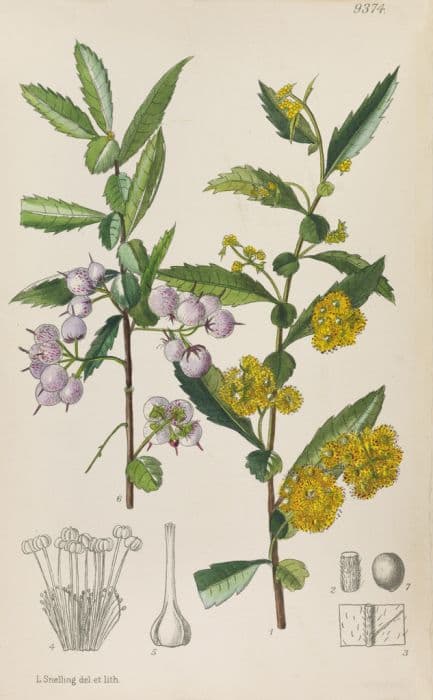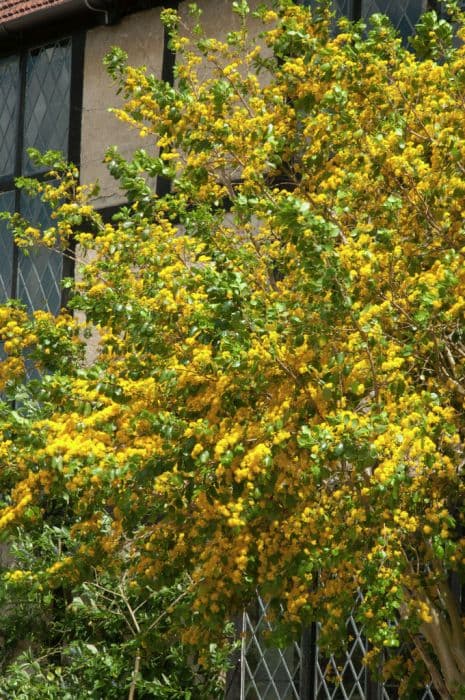Willow 'Mark Postill' Salix 'Mark Postill' (f)

ABOUT
'Mark Postill' is a compact, spreading, deciduous shrub, to 1m tall and 2m wide, with purplish-brown winter shoots. Rounded to elliptic leaves emerge a pale green when young becoming downy-white before darkening with age. Stout, greenish-yellow catkins are borne over a long period in spring
About this plant
 Names
NamesFamily
Salicaceae
Synonyms
Mark Postill Willow, Mark Postill Weeping Willow
Common names
Salix 'Mark Postill'
 Characteristics
CharacteristicsLife cycle
Perennials
Foliage type
Deciduous
Color of leaves
Green
Height
6 feet (1.83 meters)
Spread
5 feet (1.52 meters)
Plant type
Tree
Hardiness zones
5
Native area
Europe
Benefits
 General Benefits
General Benefits- Ornamental Beauty: Adds aesthetic appeal to gardens with its distinctive foliage and catkins.
- Wildlife Habitat: Provides shelter and food for birds and insects.
- Erosion Control: Helps stabilize soil and prevent erosion with its robust root system.
- Windbreak: Acts as a protective barrier against strong winds when planted in groups.
- Adaptability: Tolerates a range of soil types and conditions, making it versatile for different landscapes.
- Low Maintenance: Requires minimal upkeep once established, saving time and effort for gardeners.
- Seasonal Interest: Offers visual interest throughout the seasons with changing leaf colors and spring catkins.
- Compact Growth: Suitable for smaller gardens due to its relatively modest size compared to other willows.
 Medical Properties
Medical PropertiesThis plant is not used for medical purposes.
 Air-purifying Qualities
Air-purifying QualitiesThis plant is not specifically known for air purifying qualities.
 Other Uses
Other Uses- Salix 'Mark Postill', commonly known as Willow, can be used in basket weaving due to its flexible stems and branches that can be woven together to create sturdy containers.
- The wood of Willow trees can be used to create cricket bats as it is tough and shock-resistant, making it ideal for the sport.
- Branches from Willow trees are often used in the creation of living structures, such as arbors or tunnels in gardens, because they easily take root when planted.
- In landscape design, Willows are used for erosion control due to their extensive root systems, particularly useful near riverbanks and water bodies.
- Willow branches are sometimes used as natural support stakes for other plants instead of buying traditional bamboo or metal stakes.
- The flexible young shoots of Willow can be used in artisan crafts, including making of dream catchers or decorative wreaths.
- Willow wood can be used to produce charcoal which is often used by artists for drawing.
- Some cultures use Willow branches in traditional rituals or ceremonies, such as the making of besom brooms used in weddings or handfastings.
- Willow is used in the production of bioenergy as its fast growth and high calorific value make it suitable for biofuel and biomass production.
- The bark of the Willow tree can be converted into a rough fabric for artistic or design purposes, though this is not a common practice.
Interesting Facts
 Feng Shui
Feng ShuiThe Weeping Willow is not commonly used in Feng Shui practice.
 Zodiac Sign Compitability
Zodiac Sign CompitabilityThe Weeping Willow is not used in astrology practice.
 Plant Symbolism
Plant Symbolism- Flexibility - The willow tree, which is what 'Salix' refers to, is commonly associated with flexibility due to its slender and supple branches that bend without breaking.
- Growth and Renewal - Willows are fast-growing and can regenerate from a single dropped branch, symbolizing new beginnings and the ability to grow and prosper from loss.
- Grief and Mourning - In history and literature, willow trees are often linked with sorrow and mourning, partly due to their drooping appearance which can resemble weeping.
- Healing - Willow bark has been used for its medicinal properties, particularly salicin, which is similar to the active ingredient in aspirin, hence the willow can symbolize healing.
- Intuition and Dreams - Some cultures believe willows are magical trees that enhance psychic abilities, symbolizing a deeper understanding and connection with dreams and intuitions.
 Water
WaterThe weeping willow should be watered deeply once or twice a week during dry periods, ensuring that the soil is thoroughly saturated. In the first growing season, it is essential to establish a deep root system, which may require watering two to three times weekly depending on the weather. As the tree matures, it typically requires less frequent watering, but during prolonged droughts, it may still need supplemental watering. When watering, provide about 15 to 20 gallons for young trees each time to encourage deep root growth.
 Light
LightWeeping willows thrive best in full sunlight, meaning they need at least six hours of direct, unfiltered sunlight each day. The ideal spot for planting a weeping willow is an open area away from buildings and other shade structures to ensure it receives ample sunlight for healthy growth.
 Temperature
TemperatureWeeping willows are hardy in a wide range of temperatures and can survive in zones 4 to 8, where minimum winter temperatures can drop down to -30 degrees Fahrenheit. They perform best in moderate climates where the temperature typically ranges from 35 to 85 degrees Fahrenheit. Extreme temperatures above 100 degrees Fahrenheit might stress the tree, and additional care might be necessary.
 Pruning
PruningPruning a weeping willow is done to shape the tree, remove dead or damaged branches, and promote healthy growth. Pruning should be carried out in late winter or early spring before the sap starts to flow and new growth begins. Thin out the canopy every few years to let light and air into the inner tree, and remove any suckers from the base as needed throughout the year.
 Cleaning
CleaningAs needed
 Soil
SoilWillow 'Mark Postill' thrives best in consistently moist, well-drained soil with a pH range of 5.5 to 7.5. A mix of loam, peat, and sand can ensure adequate moisture retention and drainage. Adding organic matter will further enrich the soil conditions favorable for this willow variety.
 Repotting
RepottingDwarf Willows like 'Mark Postill' typically don't require frequent repotting if planted in the ground. If grown in containers, repot every 2-3 years to refresh the soil and accommodate root growth.
 Humidity & Misting
Humidity & MistingWillows 'Mark Postill' prefer high humidity environments resembling their natural wetland habitats. They are adaptable but thrive with ambient humidity, especially when grown near bodies of water.
 Suitable locations
Suitable locationsIndoor
Provide bright light, keep soil moist for indoor 'Mark Postill'.
Outdoor
Plant in sun, moist soil; protect from wind for outdoor 'Mark Postill'.
Hardiness zone
4-8 USDA
 Life cycle
Life cycleSalix 'Mark Postill', commonly known as Dappled Willow, begins its life cycle when seeds, typically dispersed by wind or water, germinate in moist soil conditions in the spring. Seedlings emerge rapidly, given adequate moisture and light, and the plant enters a vigorous juvenile growth phase, quickly establishing a root system and producing shoots. As it matures, the Dappled Willow develops distinctive mottled leaves, pink shoots in spring and stems that provide ornamental value throughout the growing season. After a few years, the plant reaches reproductive maturity and produces catkins that are pollinated mainly by insects, leading to seed formation and dispersal. This fast-growing shrub can also propagate vegetatively through cuttings, which root easily and contribute to the spread of the plant. Eventually, after many years, the Dappled Willow may experience reduced vigor and enter a senescent stage before dying, although exact lifespan varies widely depending on environmental conditions and care.
 Propogation
PropogationPropogation time
Early Spring
Salix 'Mark Postill', commonly known as dappled willow, is typically propagated through hardwood cuttings. This method is most effective when undertaken in late fall to early winter, during the plant's dormant period. To propagate dappled willow via hardwood cuttings, one should select a healthy stem from the current year's growth and cut a section approximately 6 to 9 inches (15 to 23 centimeters) in length. The bottom cut should be made just below a node, and the top cut should be just above a node. Stripping the leaves from the lower two-thirds of the cutting is recommended, leaving some at the top to enable photosynthesis. The cutting should then be inserted into well-draining soil or a potting mix, with roughly half of its length submerged. To encourage root growth, the cutting can be dipped in rooting hormone before planting. Maintaining consistent moisture is crucial for successful rooting, which typically occurs over a few weeks to a few months.









